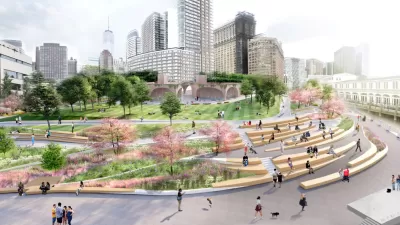New York, like every other city in the United States, isn't more prepared for a major storm event than it was on October 29, 2012.

Five years after Superstorn Sandy, the splashy and widely referenced "The Big U" plan is still "just lines on paper" according to an article by Robert Lewis.
You probably remember the Big U—"a 10-mile U-shaped barrier from 57th Street on the west side, down the battery and up the east side to 42nd Street," writes Lewis. "It was supposed to feature public art space and stunning new parkland."
A first phase of the Big U, the East Side Coastal Resiliency Project, has $335 in funding from the federal government, but the "groundbreaking has been delayed by at least 18 months, and already some of the amenities promised to the community have been removed to cut costs."
According to Lewis, the Big U is not the only project that emerged in the days and months following Superstorm Sandy that seems to have sputtered out of political favor. In fact, the assessment looks a lot like the city of New York and the surrounding region is no more prepared for an extreme weather even than it was when Superstorm Sandy slammed ashore exactly five years ago today. That dire assessment about the overall state of resilience in New York, as well as the rest of the country, is echoed by another article by the Associated Press, if you're looking for more.
FULL STORY: Why 'The Big U' Storm Barrier Could End Up as 'Half a J'

Maui's Vacation Rental Debate Turns Ugly
Verbal attacks, misinformation campaigns and fistfights plague a high-stakes debate to convert thousands of vacation rentals into long-term housing.

Planetizen Federal Action Tracker
A weekly monitor of how Trump’s orders and actions are impacting planners and planning in America.

Chicago’s Ghost Rails
Just beneath the surface of the modern city lie the remnants of its expansive early 20th-century streetcar system.

Bend, Oregon Zoning Reforms Prioritize Small-Scale Housing
The city altered its zoning code to allow multi-family housing and eliminated parking mandates citywide.

Amtrak Cutting Jobs, Funding to High-Speed Rail
The agency plans to cut 10 percent of its workforce and has confirmed it will not fund new high-speed rail projects.

LA Denies Basic Services to Unhoused Residents
The city has repeatedly failed to respond to requests for trash pickup at encampment sites, and eliminated a program that provided mobile showers and toilets.
Urban Design for Planners 1: Software Tools
This six-course series explores essential urban design concepts using open source software and equips planners with the tools they need to participate fully in the urban design process.
Planning for Universal Design
Learn the tools for implementing Universal Design in planning regulations.
planning NEXT
Appalachian Highlands Housing Partners
Mpact (founded as Rail~Volution)
City of Camden Redevelopment Agency
City of Astoria
City of Portland
City of Laramie





























